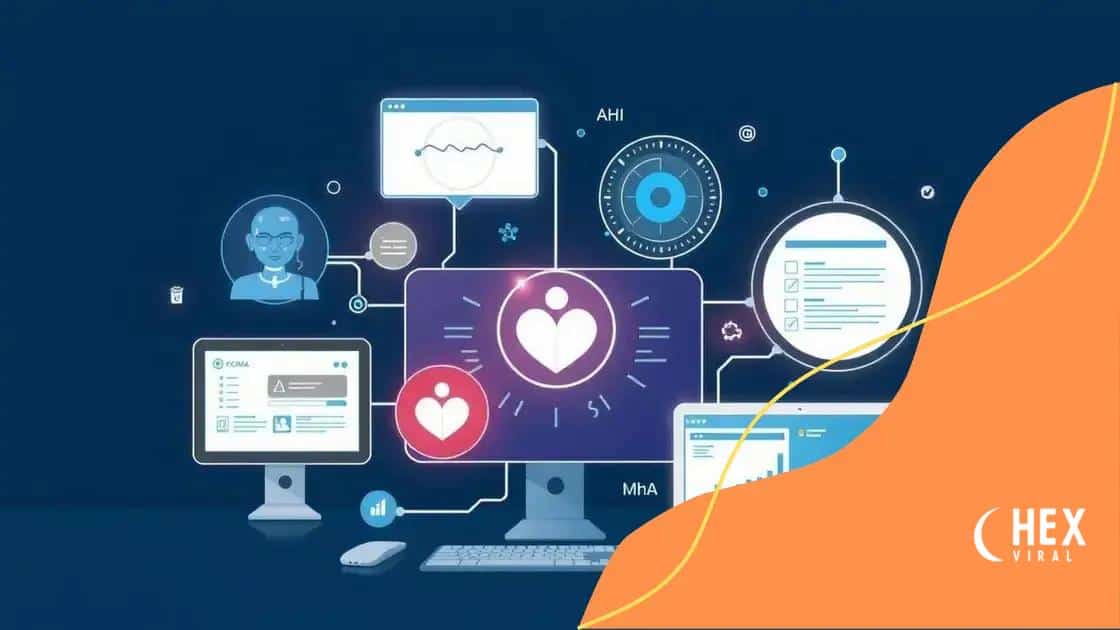Medicaid enrollment automation projects: transforming access

Medicaid enrollment automation streamlines the application process, enhances user experience, and improves data accuracy, ultimately increasing access to essential healthcare services for eligible individuals.
Medicaid enrollment automation projects are redefining how individuals gain access to essential health services. Have you ever considered how technology reshapes our interactions with healthcare systems? In this article, we’ll dive into the benefits and innovations that these projects bring.
Understanding Medicaid enrollment automation
Understanding Medicaid enrollment automation is crucial for improving healthcare access. This process helps streamline how eligible individuals enroll in Medicaid, making it easier for them to receive necessary services. To grasp the significance of this, let’s explore key concepts and benefits that accompany enrollment automation.
What is Medicaid enrollment automation?
Medicaid enrollment automation refers to using technology to simplify and accelerate the enrollment process. By replacing manual methods with automated systems, states can enhance efficiency and reduce errors. With automation, information is processed quickly, allowing faster access to health coverage.
Benefits of Medicaid enrollment automation
There are several advantages to implementing enrollment automation:
- Increased efficiency in processing applications.
- Reduction in paperwork, leading to fewer errors.
- Improved user experience for applicants.
- Greater ability to reach eligible individuals.
These benefits contribute to a more effective healthcare system, ultimately ensuring that individuals receive the care they need. Moreover, with the ongoing evolution of technology, Medicaid enrollment processes are becoming increasingly adaptable.
Additionally, automation aids in gathering valuable data about enrollment trends. This data can inform policy decisions and highlight areas requiring improvement. Agencies can better target outreach by understanding enrollment patterns, allowing them to connect with those who may be unaware they qualify for Medicaid.
Key components of enrollment automation
Several technologies fuel Medicaid enrollment automation:
- Online portals that facilitate application submissions.
- Data-sharing agreements between agencies for better accuracy.
- AI-driven chatbots to assist applicants in real-time.
Each of these components plays a vital role in making the enrollment process more accessible. As more states adopt these technologies, the future of Medicaid looks promising, with improved connections between eligible individuals and available healthcare services.
Benefits of automating enrollment processes
Exploring the benefits of automating enrollment processes reveals how technology enhances the efficiency and accessibility of Medicaid programs. Automation not only transforms workflows but also improves the overall experience for those seeking health coverage.
Streamlined Application Process
Automating enrollment helps simplify the application process for individuals. By reducing steps and waiting times, applicants find it easier to access necessary healthcare services. A well-designed system ensures that users can quickly submit their information without unnecessary complications.
Improved Accuracy
With manual processes, errors can easily occur. Automation minimizes such mistakes, allowing for better data integrity. When individuals submit their applications, automated systems can cross-verify information, ensuring everything is accurate before moving forward. This results in fewer delays and a smoother enrollment experience.
Moreover, accurate data collection enables better resource allocation. Agencies can analyze data trends to improve their services, catering better to community needs. This not only helps the agencies but also supports the individuals who rely on Medicaid.
Enhanced User Experience
By incorporating intuitive online platforms, the user experience during enrollment improves significantly. Applicants can navigate easily, find necessary information, and receive assistance when needed through chatbots or online support. Such features empower users and instill confidence in the process.
- Increased access to guidance during the application.
- Real-time updates on application status.
- Personalized communication tailored to individual needs.
Automation also ensures that updates to information are processed immediately. Individuals are notified promptly, allowing them to respond quickly to any changes or requests from the agency. This rapid feedback loop fosters trust and encourages continued engagement with the Medicaid system.
Key technologies driving automation

Understanding the key technologies driving automation in Medicaid enrollment is essential for grasping how healthcare becomes more accessible. These technologies streamline processes and ensure that eligible individuals receive timely assistance.
Artificial Intelligence (AI)
AI plays a significant role in enhancing the efficiency of enrollment processes. By analyzing data quickly, AI algorithms can identify potential applicants and streamline communication. For instance, chatbots can assist users in real time, answering questions and guiding them through the enrollment process.
Online Portals
Online enrollment portals have transformed how applicants interact with Medicaid services. These user-friendly platforms allow individuals to submit their applications online, ensuring that they can do so at their convenience. By providing a straightforward interface, these portals help minimize confusion and increase participation.
Data Analytics
Data analytics is another critical component that empowers agencies to make informed decisions. By tracking enrollment patterns, agencies can identify trends and gaps in service, allowing them to target outreach efforts effectively. This not only optimizes resources but also enhances user experience.
- Real-time reporting to monitor application statuses.
- Customized outreach based on demographic data.
- Feedback collection from users to improve systems.
Moreover, integrating various technologies helps ensure seamless communication among departments. When agencies share information, it creates a holistic view of the user’s needs, fostering better service. As these technologies continue to evolve, the potential for improving Medicaid enrollment processes remains vast, leading to better healthcare access for everyone.
Challenges in Medicaid enrollment automation
Understanding the challenges in Medicaid enrollment automation is vital for recognizing the obstacles that hinder the full potential of these innovative systems. While automation offers numerous benefits, it also presents specific hurdles that must be addressed.
Technical Limitations
One major challenge is the presence of technical limitations within existing systems. Legacy systems often struggle to integrate with new technologies. This incompatibility can lead to delays in processing applications and accessing data. Upgrading these systems can be costly and time-consuming, leaving gaps in service.
User Adoption
Another significant issue is user adoption. Many individuals, especially older applicants, may feel uncomfortable using online platforms or automated services. This discomfort can result in confusion and reluctance to embrace these new systems. Training and support are needed to help users feel more comfortable navigating these technologies.
Data Privacy Concerns
Data privacy remains a critical challenge as well. Automated systems must handle sensitive personal information securely. Any breach or misuse of data can lead to severe consequences for both the individual and the agency. Establishing robust privacy protocols is essential for building trust among users.
- Ensuring compliance with state and federal regulations.
- Implementing secure data encryption methods.
- Educating users about data privacy rights.
Furthermore, maintaining clear communication between agencies can be problematic. Different departments often use varying technologies and processes, leading to inconsistencies in how applications are handled. Resolving these discrepancies is essential to provide a seamless experience for users seeking enrollment.
As agencies recognize these challenges, they can begin to implement strategies to mitigate them. By fostering collaboration and prioritizing user education, the path to successful enrollment automation becomes clearer.
Future trends in Medicaid automation
Looking into the future trends in Medicaid automation reveals exciting developments that promise to enhance the enrollment experience. These advancements are likely to make accessing healthcare services even easier for eligible individuals.
Increased Use of Artificial Intelligence
Artificial intelligence (AI) will continue to evolve and play a pivotal role in Medicaid automation. AI algorithms can analyze data to predict trends and identify potential applicants. This means that agencies can efficiently reach out to those who may qualify, enabling proactive engagement rather than reactive responses.
Enhanced Data Security Measures
As concerns about data privacy persist, the future will witness improvements in security measures for safeguarding personal information. Enhanced encryption methods and compliance with stricter regulations will become standard practices. This will help build trust among users as they navigate the Medicaid enrollment process.
- Implementation of biometric verification technologies.
- Advanced real-time monitoring for data breaches.
- Increased transparency in data management policies.
Moreover, the integration of blockchain technology may be explored to enhance data security and integrity. Blockchain offers a decentralized way of storing information, making it difficult for unauthorized access to occur.
User-Centric Design Improvements
Future developments will also focus on creating more user-centered enrollment experiences. This includes designing intuitive interfaces that cater to individuals across different age groups and tech-savviness levels. Simplicity will be paramount, ensuring that applicants can easily find what they need without feeling overwhelmed.
Alongside these design improvements, incorporating feedback mechanisms will allow users to voice their experiences and challenges. This will help agencies refine their tools continuously, meeting the evolving needs of applicants.
As technology advances, the potential for automated systems to become adaptive and responsive will increase. The goal is to create an ecosystem where Medicaid enrollment becomes seamless, ultimately leading to improved healthcare access for all.
In conclusion, the journey towards improving Medicaid enrollment automation is filled with promise and potential. As we embrace technology, we can expect enhanced efficiency, better user experiences, and increased access to essential health services. While challenges remain, such as data privacy and user comfort, ongoing advancements will guide us toward solutions. By focusing on user-centric designs and integrating innovative technologies, we create a future where enrolling in Medicaid is seamless and accessible for all. Together, we can ensure that everyone has the opportunity to access the healthcare they need.
FAQ – Frequently Asked Questions about Medicaid Enrollment Automation
What are the main benefits of Medicaid enrollment automation?
The main benefits include increased efficiency, improved user experience, and better data accuracy, which leads to faster access to healthcare services.
What technologies are driving Medicaid enrollment automation?
Key technologies include artificial intelligence, online enrollment portals, and advanced data analytics.
What challenges does Medicaid enrollment automation face?
Challenges include technical limitations of legacy systems, user adoption issues, and concerns about data privacy and security.
How can automation improve user experience in Medicaid enrollment?
Automation creates user-friendly platforms that simplify the application process and provide real-time assistance, making it easier for people to enroll.






